
Embracing Urban Green Space in New York City
Amidst New York City’s concrete jungle, green spaces are increasingly sprouting about. As outdoor living space becomes more coveted by urban dwellers, both New York residential and commercial real estate sectors have incorporated environmentally friendly and engaging amenities to buildings across the five boroughs.
According to NYC Department of Design and Construction, green buildings are the future of New York. The most popular green building technique is the green roof. When a rooftop is partially or completely covered with vegetation, it can absorb rainwater, provide insulation, create a wildlife habitat, lower urban air temperatures and reduce heat island effect. Specifically, Green Roofs for Healthy Cities cites green roofs retain 70-90 percent of the participation that falls on them in summer depending on the plants and depth of growing medium; in winter, green roofs retain between 25-40 percent. Additionally, noise reduction green roofs can reduce exterior sound by 40-50 decibels which is a rare perk in a city that never sleeps.
In fact, according to both Green Roofs for Healthy Cities and the U.S. Green Building Council network, the use of green roofs in America has grown steadily since about 2004, but the biggest spike was in 2011 when the total area of green roofs more than doubled – from 8 million square feet in 2010 to over 16 million square feet in 2011.
Reducing impact on the environment is becoming a luxury in itself. Mansion Global reports that across the United States, landscape architects are being asked to create outdoor spaces, beyond rooftops, that reduce water and energy consumption and utilize more locally sourced materials. Environmental standards have proven to be important to tenants and buyers since they provide residents with mental benefits as a result of easy access to fresh air and sunlight. Green space is increasingly becoming an expectation rather than an afterthought for developers and architects alike.
In a recent article by Curbed, Karrie Jacobs explores how high-tech agriculture and mother nature meet on urban rooftops. Jacobs visits the Brooklyn Grange Rooftop Farm that produces about 50,000 pounds of vegetables a year, most of which are sold directly to restaurants and small greengrocers. The goal is to turn unproductive urban space into productive urban space. Beyond solely operating as a farm, Brooklyn Grange Rooftop also consults and designs urban farming spaces to outside clients. In fact, it has installed a 2,000 square-foot vegetable garden and 20,000 square-foot meadow for Vice Media’s Brooklyn offices.
The U.S. Green Building Council explains an easy yet still productive use of smaller New York green roofs is by keeping bees – an endangered species. According to AM New York, one of New York’s pioneering beekeepers is Andrew’s Honey. The fourth-generation beekeeper manages about 50 colonies across the city, including at the Waldorf Astoria, which has 360,000 European honeybees in six hives on its 20th-floor rooftop. About twice a year, Cote harvests the sweet stuff from the hives, which is used throughout the hotel in food, for tea and, come October, a special honey-laced beer created by Empire Brewing Company. Beyond bees, rooftops also provide habitats for urban animals like birds constantly being shooed from city streets.
Interestingly, JetBlue partnered with non-profit group GrowNYC, TERRA Chips and the Port Authority of New York and New Jersey to build its very own vegetable farm in Terminal 5 at JFK airport called T5 Farm. According to NPR, JetBlue hopes to promote urban agriculture, supply local schoolchildren with a living laboratory of healthy food, give free product to crew members and add green space to the customer experience.
In residential real estate, urban farms in apartments are seen as an additional selling point. Earlier this year, The New York Post reported that the 900-unit URBY Staten Island apartment complex will supply herbs and vegetables to an on-site Coffeed restaurant and its vegetables will be sold to tenants and visitors in the complex’s grocery store as well. Offering an urban farm helps attract a younger, creative crowd that The Post refers to as “locavore hipsters,” helping Staten Island compete with trendy Brooklyn in attracting desirable millennial buyers/renters.
Looking to the future in Manhattan, the Weston Baker Creative Group has proposed a mixed-use apartment high-rise that would encompass 10 floors of indoor farming terraces. According to Inhabitat, observers from the elevated park will be able to look into the indoor farming terraces that are accessible exclusively to the building’s residents. Residents will benefit from the farm’s organic produce, but onlookers will be educated in urban farming happening in the middle of New York City. While plans have yet to be approved, environmental supporters are rooting for the glass-enclosed farm and condo hybrid design to become reality.
While creating urban greenspaces and farms does come with an upfront cost, they provide abundant benefits for everyone — including people, insects and animals. Thankfully, with advances in technology creating efficient materials from refined, flexible goods, developers have seen a decreased upfront cost and quicker return on investment making green initiatives more accessible. The U.S. Green Building Council believes inclusive urban green space is a trend here to stay, and one we are only going to see more in in real estate development.